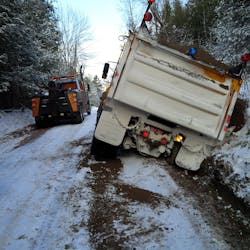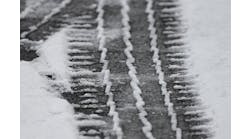Gravel and loose-top surfaced roads were, in the earliest days of roadbuilding, pretty much all you got.
These roads made up the majority of mileage for any municipal agency. Maintaining these loose-top roads became the training ground for many operators both at the municipal and contracted level. However, as the industry progressed and roads became built more sustainably, gravel surfaces decreased, but not to the point of extinction. If you are not in a major metro area, chances are there will be a portion of the road network identified as gravel and loose-top roads. As these roads tend to accommodate lower traffic volumes and lower posted speed limits, they will naturally tend to slide down the priority scale as to the level of service they eventually receive. Whether there are many or just a few residents such roads serve, there is a minimum level of service and maintenance the taxpayers expect in return, and rightfully so.
So, with all the other commitments municipalities have, we should probably take a moment or two to review and examine how best those services are to be delivered in a timely, cost-efficient manner, with resource availability a priority for each agency. As every road is considered an asset to the municipality, it is incumbent upon us to understand how the structure will perform under different strategies when receiving maintenance treatments.
The substructure of gravel roads tends to be limited, which is to say it supports minimum traffic demands. With that understanding in mind, imposing certain modern technology-based winter treatments to these surfaces will do more harm than good.
It’s back to basics, so what do we want to accomplish?
- Snow removal? Not really, as it leaves the general task incomplete and may compromise the gravel surface;
- Snow plowing? Better, but it will not give us a finished activity; and
- Snow and ice control? The better selection, as it will provide a sustainable choice during the course of the winter.
Due to the road’s surface and general makeup, varying weather conditions will cause the road to react differently at any given time. This generally means gravel roads require more maintenance, thus employing suitable equipment, making a financial commitment and providing operator training take on a whole new thought process. Excessive plowing and placing/spreading of abrasives (e.g., a winter mix sand blend with minimal salt added) may physically change the road’s crown and shoulders, and compromise the load-bearing capacity of the road, creating an unstable and damaged-prone road.
Ways of handling it
When dealing with gravel roads, you need to avoid excessive sanding, as adding too many fine granular materials will create a “greasy” condition during wet, mild weather. Adding too many coarse granular materials will create a loose surface that will not compact well and will not provide or allow the desired traction to form.
Agencies should be cognizant of the residual effects of winter treatments during the subsequent spring and summer seasons. Potholes, washboarding, soil erosion, shoulder berming, ditch and culvert clogging, and outfall sedimentation can all increase.
General industry spreading rates of abrasives standards differ from one municipality to another, but if we were to identify an average among them, the range may be from 475 lb/two-lane mile to 900 lb/two-lane mile with a range of 5% to 12% salt blended in.
It is advisable to plow to the width of the road. Keep as much open as possible. Chances are the road is in a location where it is susceptible to winds, varying precipitation and fluctuations in the freeze-thaw cycle, which in turn will narrow the travelled portion quickly. In open areas, utilize the wing and “bench” back. This will give you the option of more snow storage should conditions worsen or change before staff are able to return.
When plowing gravel roads during the first couple of snow fall events of a season, it is advised to plow just above the gravel surface, preferably 1 to 2 in. By managing this tactic, a small surface is allowed to freeze and in turn provide a surface that will insulate and protect the surface, as well as create a structure that will hold the abrasives and provide the desired traction to the motoring public. From this point, if the temperatures stay below freezing, there is now a newly made surface on which the plow blades can ride. Depending on your agency’s level of service for these road classes, you will be able to meet your commitments as a lowered serviced road.
If plow hook ups are allowed, there has been added value and success with tilting back the front plow blades from approximately 55° to 45°. This approach will mitigate the scrapping of the crown in the road surface and keep it there for the spring. By having that “buffer” between the blade and surface, a better yield of materials will stay on the road and support the traction goal.
Equipment choice and availability within your agency should be considered part of any “route rationalization” review. More traditional practices rely on graders, due to their maneuverability operating on hills, and the fact that they are less intrusive to the road base, thereby providing a more methodical approach. But graders do have their limitations and are limited to plowing only. With extended route lengths, tandem and tri-axle plows retain the ability to carry more materials, so there may be an opportunity to save operators from having to make additional (dead-heading) trips back to the facility to reload in order to finish their routes.
Experienced operators also will confirm that when out in a winter event, it is important to drive on the designated lane in each direction. Driving down the middle of a gravel road may remove the crown—though the operator may not even realize it. As gravel roads usually are narrow to begin with, around 18 ft in width, it becomes a priority to clear the whole lane. By plowing at angles that create evenly dispersed windrows, site-line obstruction snow piles can be kept at a minimum.
Maintaining gravel roads can cost up to four times more than winter maintenance on asphalt roads.
Reality check
If we take a step back and review the whole gravel roads picture—from operation to costs—we would probably see a stark difference in the financial comparisons of routine maintenance between gravel and hard-top surfaces. During the course of a calendar year, it has become apparent (through opportunities of data sharing with other municipalities) that gravel roads require a huge financial commitment. Gravel roads can cost up to four times more, mile for mile, than the costs of maintaining asphalt-surfaced roads.
It is important that there is an understanding within and among agencies that how we as road owners treat the roads during the winter season will have a direct impact on what those roads’ condition or legacy will be once the snow and ice melt away. Does it mean we grade the road two, three or four times more during the next six months? Are there concerns with drainage? Is the rainwater flowing freely where it needs to go? Is runoff ditching overwhelmed by excessive sand use?
And with this better understanding, we just may be able to provide a financial cost structure, mitigate overuse of operating resources and lessen environmental impacts, while offering a reasonable service level during winter storm events. Know what your agency’s capabilities and resources are, and use them wisely. The implications after the winter will come back at us many times more.


